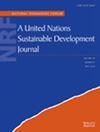金融部门发展与可再生能源消费的关系:来自全球动态面板阈值分析的证据
IF 3.5
4区 社会学
Q2 ENVIRONMENTAL SCIENCES
引用次数: 0
摘要
经济去碳化要求能源从传统能源过渡到可再生清洁能源。然而,这种过渡在很大程度上取决于是否有巨额投资来管理高昂的启动成本和运营基础设施。在这方面,金融部门可以发挥至关重要的作用。本研究利用金融机构和金融市场构成的金融业发展综合衡量标准,探讨了金融业在可再生能源消费中的作用。此外,本研究还利用先进的计量经济学技术 "动态面板阈值模型",对 1980 年至 2019 年 165 个国家的面板数据进行了分析。实证分析表明,金融发展总指数、金融机构指数和金融市场指数分别存在0.191、0.196和0.008的阈值。这一结果证实了金融业发展与可再生能源消费之间存在 U 型曲线,验证了金融库兹涅茨曲线的存在。因此,金融业发展在初期会降低可再生能源的消耗,而在达到临界水平后,则会促进可再生能源的消耗。此外,研究还表明,经济增长、贸易开放度和通货膨胀在解释可再生能源的使用方面具有显著的统计学作用。研究结果表明,迫切需要改善金融机构和市场,使金融部门的表现超过临界水平,从而支持可再生能源消费的增长。本文章由计算机程序翻译,如有差异,请以英文原文为准。
Financial sector development and renewable energy consumption nexus: Evidence from global dynamic panel threshold analysis
Decarbonizing economies requires an energy transition from conventional energy resources to renewable and clean energy resources. However, this transition largely depends upon the availability of huge investments to manage high start‐up costs and operational infrastructure. In this respect, the financial sector can play a vital role. This study explores the financial sector's role in renewable energy consumption utilizing a comprehensive measure of financial sector development constituting both financial institutions and financial markets. Moreover, the study utilizes an advanced econometric technique “dynamic panel threshold model” on panel data of 165 countries ranging from 1980 to 2019. The empirical analysis reveals the presence of a threshold value of 0.191, 0.196, and 0.008 for the overall financial development index, financial institutions index, and financial market index, respectively. This finding confirms the presence of a U‐shaped curve between financial sector development and renewable energy consumption, validating the existence of the financial Kuznets curve. Thus, initially, financial sector development results in lower renewable energy consumption while after reaching the threshold level it boosts renewable energy consumption. Furthermore, the study also shows the statistically significant role of economic growth, trade openness, and inflation in explaining renewable energy usage. The obtained outcomes suggest a pressing necessity to improve both financial institutions and markets to surpass the threshold levels of financial sector performance within the financial sector, thus supporting a rise in renewable energy consumption.
求助全文
通过发布文献求助,成功后即可免费获取论文全文。
去求助
来源期刊

Natural Resources Forum
环境科学-环境科学
CiteScore
6.10
自引率
0.00%
发文量
24
审稿时长
>36 weeks
期刊介绍:
Natural Resources Forum, a United Nations Sustainable Development Journal, focuses on international, multidisciplinary issues related to sustainable development, with an emphasis on developing countries. The journal seeks to address gaps in current knowledge and stimulate policy discussions on the most critical issues associated with the sustainable development agenda, by promoting research that integrates the social, economic, and environmental dimensions of sustainable development. Contributions that inform the global policy debate through pragmatic lessons learned from experience at the local, national, and global levels are encouraged.
The Journal considers articles written on all topics relevant to sustainable development. In addition, it dedicates series, issues and special sections to specific themes that are relevant to the current discussions of the United Nations Commission on Sustainable Development (CSD). Articles must be based on original research and must be relevant to policy-making.
Criteria for selection of submitted articles include:
1) Relevance and importance of the topic discussed to sustainable development in general, both in terms of policy impacts and gaps in current knowledge being addressed by the article;
2) Treatment of the topic that incorporates social, economic and environmental aspects of sustainable development, rather than focusing purely on sectoral and/or technical aspects;
3) Articles must contain original applied material drawn from concrete projects, policy implementation, or literature reviews; purely theoretical papers are not entertained.
 求助内容:
求助内容: 应助结果提醒方式:
应助结果提醒方式:


